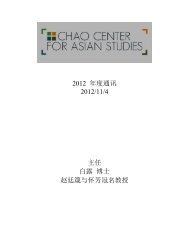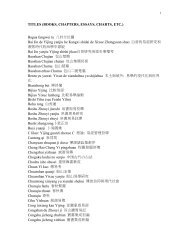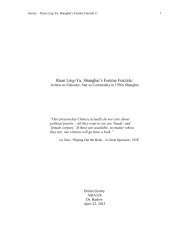Jesuit Interpretations of the Yijing - Chao Center for Asian Studies ...
Jesuit Interpretations of the Yijing - Chao Center for Asian Studies ...
Jesuit Interpretations of the Yijing - Chao Center for Asian Studies ...
You also want an ePaper? Increase the reach of your titles
YUMPU automatically turns print PDFs into web optimized ePapers that Google loves.
8<br />
According to him, odd numbers began in <strong>the</strong> north (<strong>the</strong> origin <strong>of</strong> all yang tendencies)<br />
with one, and passed clockwise through three, seven, and nine, <strong>the</strong>reby describing one<br />
circuit <strong>of</strong> accumulation (xi) and dispersal (xiao). Even numbers began in <strong>the</strong> south and<br />
followed a similar clockwise path from two through four, six, and eight. With variations,<br />
<strong>the</strong> same process could be used with <strong>the</strong> Luoshu. 20 [FIGURE 4 (a diagram from Lai's<br />
book)]<br />
Paralleling <strong>the</strong> development <strong>of</strong> explanatory schemes based on <strong>the</strong> Hetu and<br />
Luoshu were elaborate configurations <strong>of</strong> hexagrams--likewise designed to reveal patterns<br />
<strong>of</strong> cosmic relationships and cosmic change. One <strong>of</strong> <strong>the</strong> most famous and influential <strong>of</strong><br />
<strong>the</strong>se, attributed to <strong>the</strong> brilliant Song dynasty scholar, Shao Yong (1011-1077), is <strong>the</strong> socalled<br />
"Fu Xi Arrangement <strong>of</strong> <strong>the</strong> Sixty-Four Hexagrams"--also known as <strong>the</strong> "Former<br />
Heaven" (Xiantian) sequence. In it, a square-shaped configuration <strong>of</strong> <strong>the</strong> sixty-four<br />
hexagrams (in which all <strong>the</strong> hexagrams in each horizontal row have <strong>the</strong> same lower<br />
trigram) is enclosed by a circle-shaped configuration in a different order (in which all yin<br />
lines at <strong>the</strong> bottom <strong>of</strong> <strong>the</strong> hexagrams are on <strong>the</strong> right side <strong>of</strong> <strong>the</strong> diagram and all yang<br />
lines at <strong>the</strong> bottom <strong>of</strong> <strong>the</strong> hexagrams are on <strong>the</strong> left side. By assigning numerical values to<br />
<strong>the</strong>se hexagrams, and by correlating <strong>the</strong>m with sets <strong>of</strong> four images (greater yin and lesser<br />
yang and lesser yin and greater yang)--each identified with one or ano<strong>the</strong>r trigram--Shao<br />
believed he could explain all phenomena in <strong>the</strong> world--all qualities, all processes, all<br />
things, all conditions, and all relationships. He developed, in short, a comprehensive<br />
correlative system by which numbers linked to <strong>the</strong> hexagrams <strong>of</strong> <strong>the</strong> Changes could<br />
express non-numerical ideas. 21<br />
One <strong>of</strong> Shao's poems, preserved in <strong>the</strong> eighteenth century Qing encylopedia Gujin<br />
tushu jicheng (Complete Collection <strong>of</strong> Illustrations and Writings, Past and Present),<br />
suggests <strong>the</strong> comprehensiveness <strong>of</strong> his world view:<br />
With nines [changing yang lines] you see a flock <strong>of</strong> dragons;<br />
The first [line <strong>of</strong> Qian] engenders all things.<br />
With sixes [changing yin lines] come eternal advantages;<br />
Because <strong>of</strong> Qian <strong>the</strong>re are benefits.<br />
Four images times nine and you get thirty-six.<br />
Four images times six and you get twenty-four.<br />
Why is it that with [nothing more than] nines and sixes<br />
All human affairs can be fathomed 22<br />
20 Lai's many charts can be found in Shi Wei and Qiu Xiaobo, eds. Zhouyi tushi da dian (A Dictionary<br />
Explaining Illustrations [Related to <strong>the</strong>] Zhou Changes). Beijing: Zhongguo gongren chuban she, 1994,<br />
803-937. The most complete account <strong>of</strong> Lai's thought in English is Larry Schulz's "Lai Chih-te (1525-<br />
1604) and <strong>the</strong> Phenomenology <strong>of</strong> <strong>the</strong> Classic Of Change (I-Ching)," Ph.D. dissertation, Princeton<br />
University, 1982. See also Zhang Qicheng, <strong>Yijing</strong> yingyong da baike (A Practical Encyclopedia <strong>of</strong> <strong>the</strong><br />
Classic <strong>of</strong> Changes), Taibei: Dijing qiye gufen youxian gongsi, 1996, 1: 267-269. For a brief Qing dynasty<br />
critique <strong>of</strong> Lai, see Jiang Yong's He Luo jingyun, 198.<br />
21 See Anne Birdwhistell, Transition to Neo-Confucianism: Shao Yung on Knoweldge and Symbols <strong>of</strong><br />
Reality, Stan<strong>for</strong>d: Stan<strong>for</strong>d University Press, 1989, 89 ff. Ibid., 78-83 provides a clear explanation <strong>of</strong><br />
Shao's distinction between word images, visual images, and number images; consult also James A. Ryan,<br />
"Leibniz's Binary System and Shao Yong's <strong>Yijing</strong>," Philosophy East and West 46.1 (January, 1996), 59-90<br />
and Toda Toyosaburo, Ekikyo chuyaku shi ko (An Historical Outline <strong>of</strong> <strong>Yijing</strong> Commentaries), Tokyo:<br />
Kazama shobo, 1968, 451-460.<br />
22 Chen Menglei, et al., eds., Qinding gujin tushu jicheng (Imperial Edition <strong>of</strong> <strong>the</strong> Complete Collection <strong>of</strong><br />
Illustrations and Writings, Past and Present), Taibei: Dingwen shuju, 1997, 55: 994.








